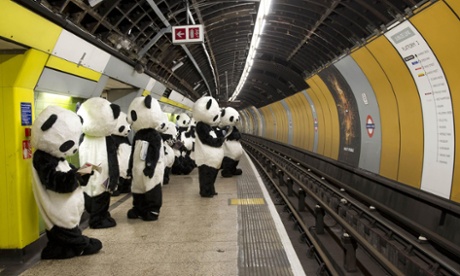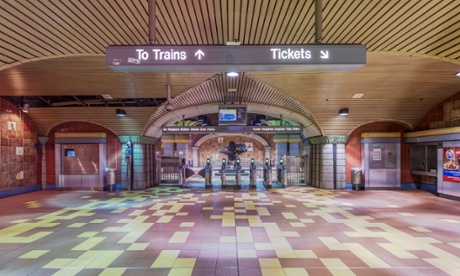Sixteen years ago, former New York transport boss Bob Kiley was recruited from across the pond to rescue the London Underground “New York Tough Guy to Run Tube,” announced the Evening Standard.
Now the reverse is happening. Andy Byford – who grew up in Plymouth and is a veteran of Transport for London, Sydney’s RailCorp and the Toronto Transit Commission – arrives to take on New York’s rammed and creaking transport system, which this year suffered a “summer of hell”. Long-deferred repairs wrought havoc on the already overburdened system, leaving passengers stranded on sweltering platforms and captive in immobilized subway cars.
During his time in Toronto, Byford rode the rails and buses every day alongside customers, wearing a conspicuous name tag and fielding questions and complaints about the service. He seems likely to get plenty of both in New York, whose passengers are not shy about giving their views on the state of the subway.
“That’s the job, and I expect to be held to account,” Byford told the Guardian, confirming he would keep up his pattern of traveling on the system he runs. “I’ll use it every day; that’s how I get about. I’ve never owned a car in my life and I don’t intend to buy a car in New York.”
Byford seemed undaunted by becoming head of the New York City Transit Authority.
“I didn’t take this on for the prestige. I took it on because I like a challenge,” he said.
He has already floated potentially unpopular ideas, like an end to 24-hour service on some lines, and closing others for repairs. “It’s a harsh message but there will be no gain without a bit of pain,” Byford said.
He added: “A lesson that I’ve applied here at the TTC [in Toronto] came from the London Underground, where once upon a time we tried to upgrade things overnight and on weekends, but came to the conclusion that sometimes [if repairs are done all at once] it’s more efficient and you get the get the job done more quickly.”
His résumé certainly appears to fit the bill. Byford started his career as a station foreman at Regent’s Park station in London in 1989 before becoming manager of King’s Cross St Pancras, and then holding leadership positions in the London, Sydney and Toronto transit systems.
He met his wife, Alison, on the London Underground, proposed to her on a high-speed train and hired a double-decker bus to take guests to their wedding in Ottawa.
Byford sees London’s underground system as a model for New York.
“Every time I go back to the Tube I’m amazed. I go to the stations and they’re bright and renovated. The station staff are incredibly proactive, they look great, they’re very helpful,” Byford told the Evening Standard.
In Toronto, Byford took over the top job in 2013, and set in motion an ambitious five-year modernization plan. Under him, on-time arrivals went up, and trains got faster. The subway, which Byford had previously described as “squalid”, got cleaner.
“He basically was looking for, in the short term, quick wins,” said Steve Munro, a veteran Toronto transit activist and blogger. “That’s the basic thing any new manager does: they come in and want to be seen as doing something. So he went after the stuff that was relatively easy and cheap to implement.”
The wins bought him time and cachet. Byford turned around and converted that political capital into bigger, deeper changes to infrastructure and agency culture. “He’s a good forceful spokesman but he’s not overbearing,” Munro said. “He made a good political case and fortunately for him, the political era was such that fixing the problem was more important than fighting about, ‘Oh God, how did we get here?’”
The effort culminated in Toronto being named “outstanding public transit system of the year” by the American Public Transportation Association.
The award was greeted skeptically by Torontonians – straphangers worldwide aren’t typically the most optimistic bunch – but the system fared much better than the one New Yorkers currently contend with every day.
According to a November New York Times investigation, on-time arrivals are down about 26% since 2007, and a majority of the city’s 20-odd service lines have on-time arrival rates below 65%. It’s not all in the numbers either. One particularly “hellworthy” summer image was that of desperate travelers, trapped in a subway car without air conditioning for more than an hour.
S/b F train stuck for over an hour w/o light and air just rolled up-passengers dripping with sweat begging to get off #mta @MTA #effedtrain pic.twitter.com/NXJ3pDJtji
— Chelsea Lawrence (@chelseahbelle) June 5, 2017
Byford was in New York for a transit function the same June day that New York’s governor, Andrew Cuomo, declared a state of emergency – a designation usually reserved for natural disasters – for the city’s subways.
New York has managed some transit wins. The city opened its first stations on the centuries-delayed Second Avenue line earlier this year, and delivered a 7 line expansion on the west side in 2015, even if both projects were beset by cost overruns and delays.
The city also made good on a promise to get every underground station equipped with wifi, and in 2017 got digital arrival bulletins into all of its 425 stations – no easy feat.But the political situation Byford walks into is complex. Cuomo and city mayor, Bill de Blasio, both Democrats, are locked in a seemingly perpetual feud, and city transit, over which they share authority, has been a common site for their skirmishes.
Byford has pledged to stay out of it: “I’m not going to even attempt to get into the middle of that relationship. My job is to give advice and for politicians to decide, and my job is to advocate for my customers.”
The task is herculean, though, and Byford is the first to admit that the system faces major limitations based on its current age, state of repair and massive ridership. “There’s a reason why that equipment is under strain. It’s old and it’s trying to carry more people than it was ever designed for,” Byford said.Byford faces the impending shutdown of the L line, the city’s busiest train route. In 2019, the tubes that connect that line underneath the East river will be taken out of operation for a total overhaul and the 225,000 daily riders will need to be accommodated. Cuomo and De Blasio have already tangled over whose mess that is to solve, and it’s not likely to smooth over any time soon. Byford admits that he’s never quite tackled a problem of that magnitude, but he’s certainly game to try.
“Any transit professional who’s worth their salt wants to do this job,” Byford said. “This is New York, for God’s sake. This is the most wonderful city and the biggest challenge, and I can’t wait.”











